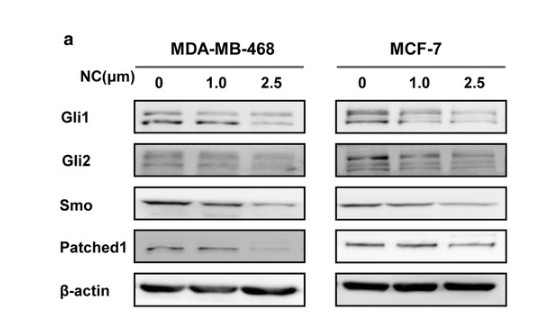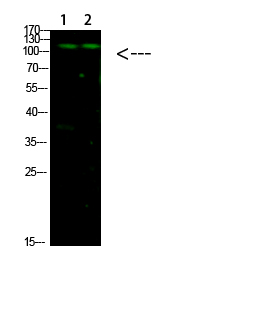GLI-1 Polyclonal Antibody
- Catalog No.:YT6073
- Applications:WB;ELISA
- Reactivity:Human;Mouse
- Target:
- GLI-1
- Fields:
- >>cAMP signaling pathway;>>Hedgehog signaling pathway;>>Pathways in cancer;>>Basal cell carcinoma
- Gene Name:
- GLI1 GLI
- Protein Name:
- GLI-1
- Human Gene Id:
- 2735
- Human Swiss Prot No:
- P08151
- Mouse Gene Id:
- 14632
- Mouse Swiss Prot No:
- P47806
- Immunogen:
- Synthesized peptide derived from human GLI-1. at AA range: 460-490
- Specificity:
- This antibody detects endogenous levels of GLI-1
- Formulation:
- Liquid in PBS containing 50% glycerol, 0.5% BSA and 0.02% sodium azide.
- Source:
- Polyclonal, Rabbit,IgG
- Dilution:
- WB 1:500-2000, ELISA 1:10000-20000
- Purification:
- The antibody was affinity-purified from rabbit antiserum by affinity-chromatography using epitope-specific immunogen.
- Concentration:
- 1 mg/ml
- Storage Stability:
- -15°C to -25°C/1 year(Do not lower than -25°C)
- Other Name:
- Zinc finger protein GLI1 (Glioma-associated oncogene) (Oncogene GLI)
- Observed Band(KD):
- 120kD
- Background:
- This gene encodes a member of the Kruppel family of zinc finger proteins. The encoded transcription factor is activated by the sonic hedgehog signal transduction cascade and regulates stem cell proliferation. The activity and nuclear localization of this protein is negatively regulated by p53 in an inhibitory loop. Multiple transcript variants encoding different isoforms have been found for this gene. [provided by RefSeq, May 2009],
- Function:
- disease:Defects in GLI1 may be a cause of breast cancer.,function:May regulate the transcription of specific genes during normal development. May play a role in craniofacial development and digital development, as well as development of the central nervous system and gastrointestinal tract. Mediates SHH signaling and thus cell proliferation and differentiation.,induction:Amplified in glioblastoma cells.,similarity:Belongs to the GLI C2H2-type zinc-finger protein family.,similarity:Contains 5 C2H2-type zinc fingers.,subcellular location:Tethered in the cytoplasm by binding to SUFU. Activation and translocation to the nucleus is promoted by interaction with STK36.,tissue specificity:Testis, myometrium and fallopian tube.,
- Subcellular Location:
- Cytoplasm . Nucleus . Tethered in the cytoplasm by binding to SUFU (PubMed:10806483). Activation and translocation to the nucleus is promoted by interaction with STK36 (PubMed:10806483). Phosphorylation by ULK3 may promote nuclear localization (PubMed:19878745). Translocation to the nucleus is promoted by interaction with ZIC1 (PubMed:11238441). .; [Isoform 2]: Cytoplasm . Nucleus .
- Expression:
- Detected in testis (at protein level) (PubMed:2105456). Testis, myometrium and fallopian tube. Also expressed in the brain with highest expression in the cerebellum, optic nerve and olfactory tract (PubMed:19878745). Isoform 1 is detected in brain, spleen, pancreas, liver, kidney and placenta; isoform 2 is not detectable in these tissues (PubMed:19706761).
Sun, Mingjuan, et al. "Hedgehog pathway is involved in nitidine chloride induced inhibition of epithelial-mesenchymal transition and cancer stem cells-like properties in breast cancer cells." Cell & bioscience 6.1 (2016): 44.
- June 19-2018
- WESTERN IMMUNOBLOTTING PROTOCOL
- June 19-2018
- IMMUNOHISTOCHEMISTRY-PARAFFIN PROTOCOL
- June 19-2018
- IMMUNOFLUORESCENCE PROTOCOL
- September 08-2020
- FLOW-CYTOMEYRT-PROTOCOL
- May 20-2022
- Cell-Based ELISA│解您多样本WB检测之困扰
- July 13-2018
- CELL-BASED-ELISA-PROTOCOL-FOR-ACETYL-PROTEIN
- July 13-2018
- CELL-BASED-ELISA-PROTOCOL-FOR-PHOSPHO-PROTEIN
- July 13-2018
- Antibody-FAQs
- Products Images

- Sun, Mingjuan, et al. "Hedgehog pathway is involved in nitidine chloride induced inhibition of epithelial-mesenchymal transition and cancer stem cells-like properties in breast cancer cells." Cell & bioscience 6.1 (2016): 44.

- Western Blot analysis of 1,mouse-liver 2,hela cells using primary antibody diluted at 1:1000(4°C overnight). Secondary antibody:Goat Anti-rabbit IgG IRDye 800( diluted at 1:5000, 25°C, 1 hour)



